Mises, Ludwig von. Human Action: A Treatise on Economics
Подождите немного. Документ загружается.

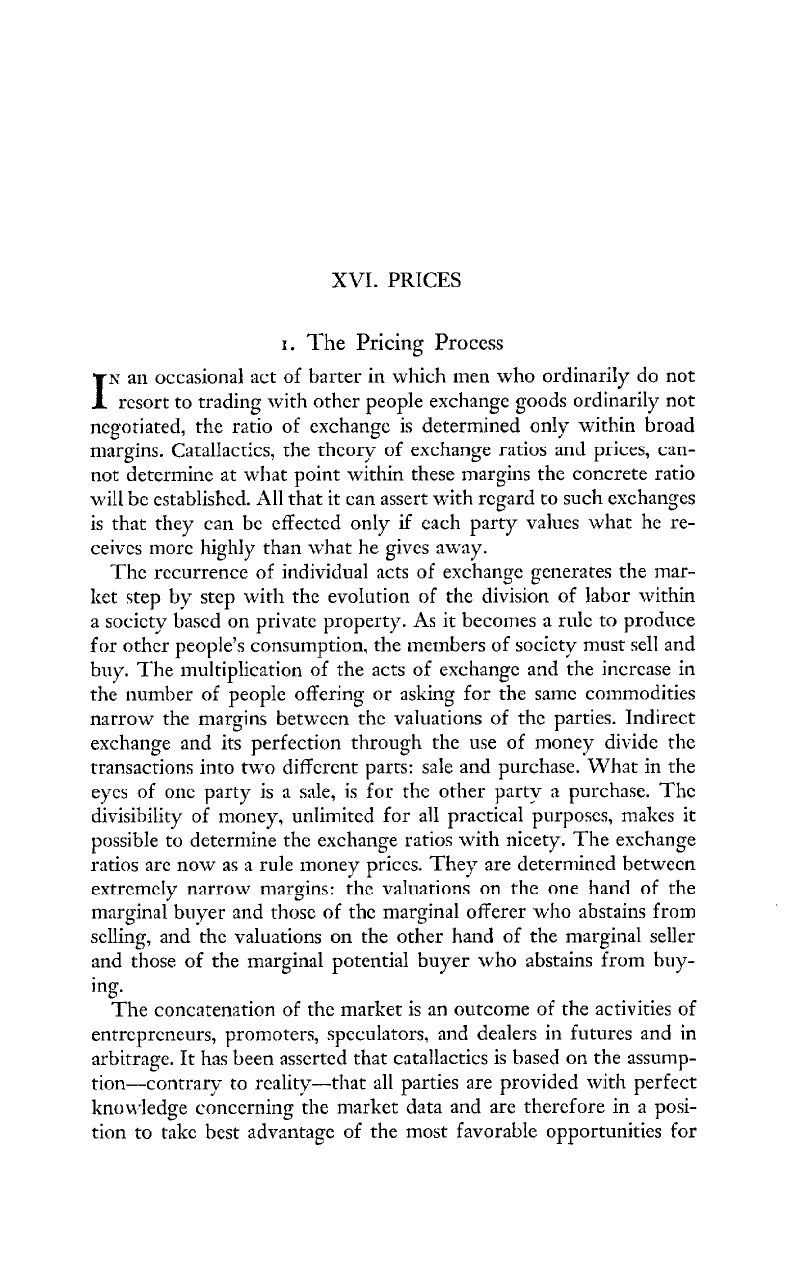
XVI.
PRICES
I.
The
Pricing Process
I
N
an occasional act of barter in which men who ordinarily do not
resort to trading with other people exchange goods ordinarily not
negotiated, the ratio of exchange is determined only within broad
margins. CatalIactics, the theory of exchange ratios and prices, can-
not determine at what point within these margins the concrete ratio
will bc established. All that it can assert with rcgard to such exchanges
is that they can be effectcd only if cach party values what hc re-
ceives more highly than what he gives away.
The recurrence of individual acts of exchange generates the mar-
ket step
by
step with the evoIution of the division of labor within
a society based on private property. As it becomes a rulc to produce
for other people's consumption, the lnernbers of society must sell and
buy.
The multiplication of the acts of exchange and the incrcase in
the number of people offering or asking for the same commodities
narrow the margins betwcen the valuations
of
the parties. Indirect
exchange and its perfection through the use of money divide the
transactions into two different parts: sale and purchase.'~hat in the
eyes of orlc party is a sale, is far thc other party
n
purchase. The
divisibility of money, unlimited for all practical purposes, maltes it
possible to determine thc exchange ratios with nicety. The exchange
ratios are now as a rule money priccs. They are
determined
between
extrcmcly narrow
margins:
tllc
valuations on the one hand of the
marginal buyer and those of the marginal offerer
who
abstains from
selling, and -the valuations on the other hand of the marginal seller
and those of the marginal potential buyer who abstains from buy-
ing.
The concatenation of the market is an outcome of the activities of
entrcprcneurs, promoters, speculators, and dealers in futures and in
arbitrage. It has been asscrted that catallactics is based on the assump-
tion-contrary- to reality-that all parties are provided with perfect
knowledge concerning the market data and are thercfore in a posi-
tion to take best advantage of the most favorable opportunities for
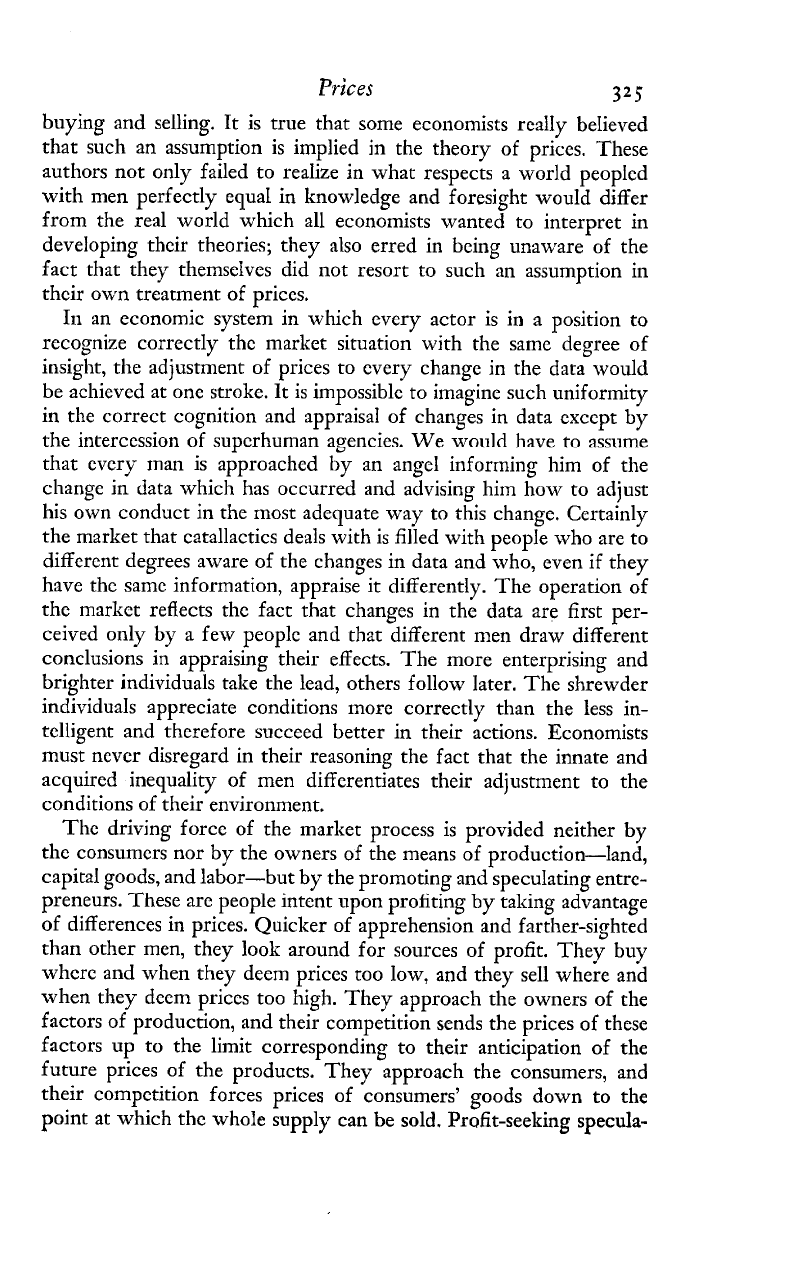
Prices
buying and selling. It is true that some economists really beIieved
that such an assumption is implied in the theory of prices. These
authors not only failed to realize in what respects a world peopled
with men perfectly equal in knowledge and foresight would differ
from the real world which all economists wanted to interpret in
developing their theories; they also erred in being unaware of the
fact that they themselves did not resort to such an assumption in
their own treatment of prices.
In
an economic system in which every actor is
in
a position to
recognize correctly the market situation with the same degree of
insight, the adjustment of prices to every change in the data would
be achieved at one stroke. It is impossible to imagine such uniformity
in the correct cognition and appraisal of changes in data cxccpt by
the intercession of supcrhurnan agencies. We would have to assume
that every man is approached by an angcl informing him of the
change in data which has occurred and advising him how to adjust
his own conduct in the most adequate way to this change. Certainly
the market that catallactics deals with is filled with people who are to
different degrees aware of the changes in data and who, even if they
have the same information, appraise it differently. The operation of
the market reflects the fact that changes in the data are first per-
ceived only by
a
few peoplc and that different men draw different
conclusions in appraising their effects. The more enterprising and
brighter individuals take the lead, others follow later. The shrewder
individuals appreciate conditions more correctly than the less in-
telligent and therefore succeed better in their actions. Economists
must never disregard in their reasoning the fact that the innate and
acquired inequality of men diffcrentiates their adjustment to the
conditions of their environment.
The driving force of the market process is provided neither by
the consumers nor by the owners of the means of production-land,
capital goods, and labor-but by the promoting and speculating entre-
preneurs. These are people intent upon profiting by taking advantage
of differences in prices. Quicker of apprehension and farther-sighted
than other men, they look around for sources of profit. They buy
where and when they deem prices too low, and they sell where and
when they deem prices too high. They approach the owners of the
factors of production, and their competition sends the prices of these
factors up to the limit corresponding to their anticipation of the
future prices of the products. They approach the consumers, and
their competition forces prices of consumers' goods down to the
point at which the whole supply can be sold. Profit-seeking specula-
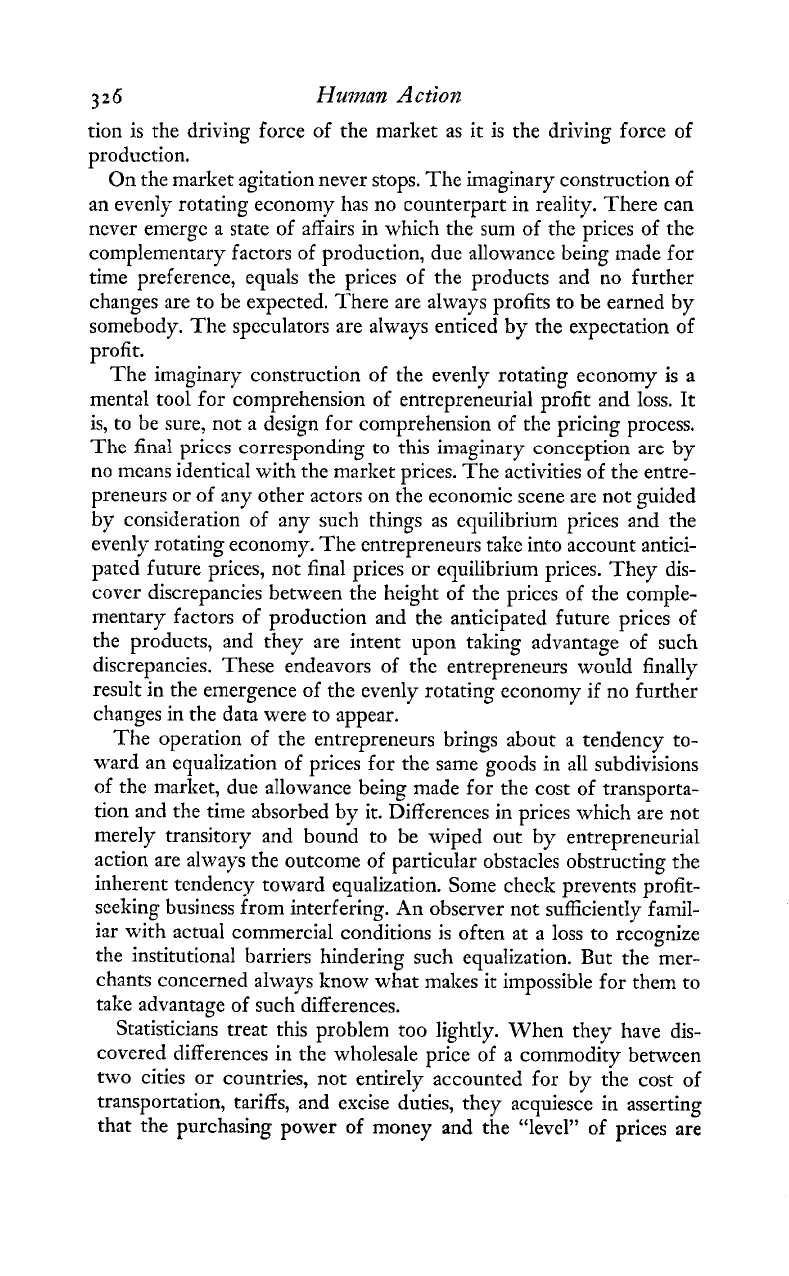
Hu~nan
Action
tion is the driving force of the market as it is the driving force of
production.
On the market agitation never stops. The imaginary construction of
an evenly rotating economy has no counterpart in reality. There can
never emerge a state of affairs in which the sum of the prices of the
complementary factors of production, due allowance being made for
time preference, equals the prices of the products and no further
changes are to be expected. There are always profits to be earned by
somebody. The speculators are always enticed by the expectation of
profit.
The imaginary construction of the evenly rotating economy is a
mental tool for comprehension of entrepreneurial profit and loss. It
is, to be sure, not a design for comprehension of the pricing process.
The final prices corresponding to this imaginary conception are
by
no tncans identical with the market prices. The activities of the entre-
preneurs or of any other actors on the economic scene are not guided
by consideration of any such things as equilibrium prices and the
evenly rotating economy. The entrepreneurs take into account antici-
pated future prices, not final prices or equilibrium prices. They dis-
cover discrepancies between the height of the prices of the comple-
mentary factors of production and the anticipated future prices of
the products, and they are intent upon taking advantage of such
discrepancies. These endeavors of the entrepreneurs would finally
result in the emergence of the evenly rotating economy if no further
changes in the data were to appear.
The operation of the entrepreneurs brings about a tendency to-
ward an equalization of prices for the same goods in all subdivisions
of the market, due aIlowance being made for the cost of transporta-
tion and the time absorbed by it. Diffcrences in prices which are not
merely transitory and bound to be wiped out by entrepreneurial
action are always the outcome of particular obstacles obstructing the
inherent tendency toward equalization. Some check prevents profit-
seeking business from interfering.
An
observer not sufficiently famil-
iar with actual commercial conditions is often at a loss to rccognize
the institutional barriers hindering such equalization. But the mer-
chants concerned always know what makes it impossible for them to
take advantage of such differences.
Statisticians treat this problem too lightly. When they have dis-
covered differences in the wholesale price of a commodity between
two cities or countries, not entirely accounted for by the cost of
transportation, tariffs, and excise duties, they acquiesce in asserting
that the purchasing power of money and the "level" of prices are
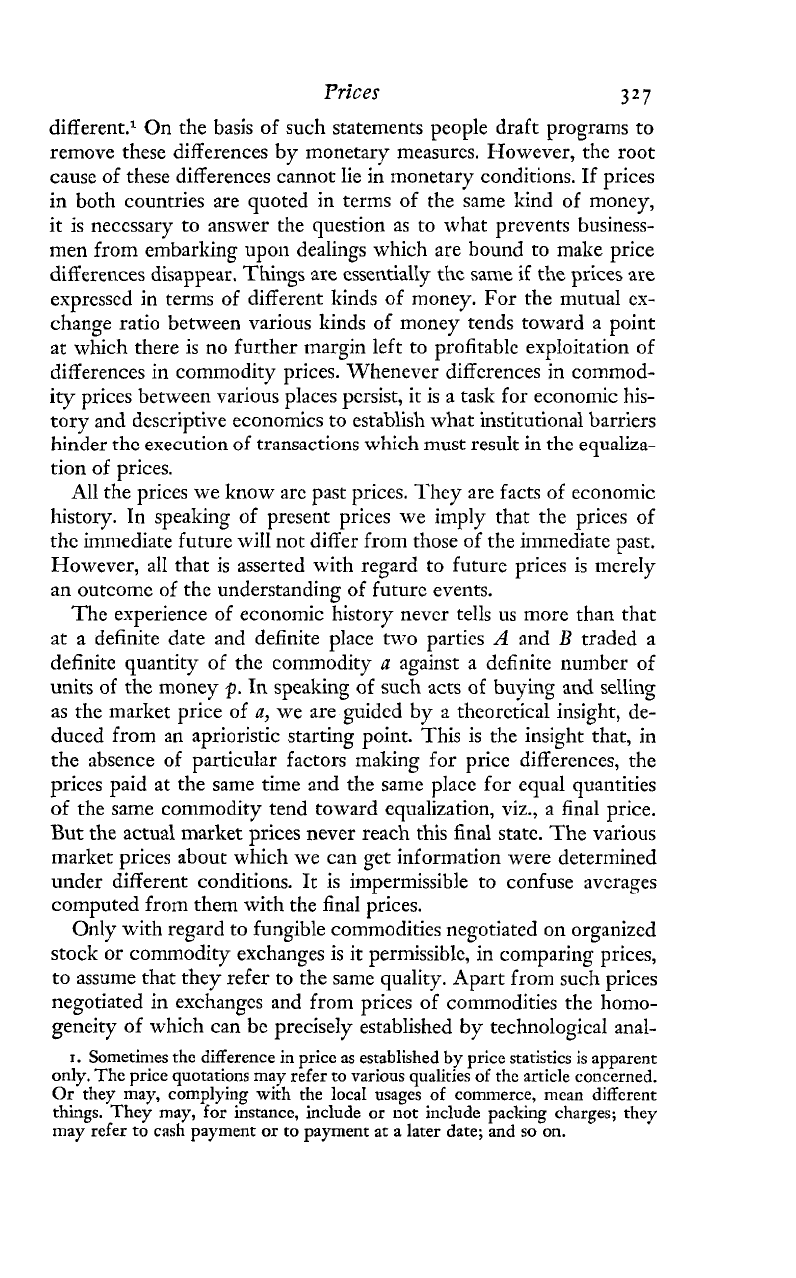
di8erent.l On the basis of such statements people draft programs to
remove these differences by monetary measures. However, the root
cause of these differences cannot lie in monetary conditions. If prices
in both countries are quoted in terms of the same kind of money,
it is necessary to answer the question as to what prevents business-
men from embarking upon dealings which are bound to make price
differences disappear. Things are essentially
the
same if the prices are
expresscd in terms of different kinds of money. For the mutual ex-
change ratio between various kinds of money tends toward a point
at which there is no further margin left to profitable expIoitation of
differences in commodity prices. Whenever differences in commod-
ity prices between various places pcrsist, it is
a
task for economic his-
tory and descriptive economics to establish what institutional barriers
hinder thc execution of transactions which must result in thc equaliza-
tion of prices.
All the prices we know arc past prices. They are facts of economic
history. In speaking of present prices we imply that the prices of
thc immediate future
wiIl
not differ from those of the immediate past.
However, all that is asserted with regard to future prices is merely
an outcome of the understanding of future events.
The experience of economic history never tells us morc than that
at a definite date and definite place two parties
A
and
I3
traded a
definite quantity of the commodity
a
against a definite number of
units of the money
p.
In speaking of such acts of
buying
and selling
as the market price of
a,
we are guided by
a
thcorctical insight, de-
duced from an aprioristic starting point. This is the insight that, in
the absence of particular factors making for price differences, the
prices paid at the same time and the same place for equal quantities
of the same commodity tend toward equalization, viz., a final price.
But
the actual market prices never reach this final state. The various
market prices about which
we
can get information were determined
under different conditions.
It
is impermissible to confuse averages
computed from them with the final prices.
Only
with regard to fungible commodities negotiated on organized
stock or commodity exchanges is it permissible, in comparing prices,
to assume that they refer to the same quality. Apart from such prices
negotiated in exchanges and from prices of commodities the homo-
geneity of which can be precisely established by technological anal-
I.
Sometimes the difference in price
as
established by price statistics is apparent
only. The price quotations may refer to various qualities of the article concerned.
Or they may, complying with the local usages of commerce, mean different
things. They may, for instance, include or not include packing charges; they
may refer to cash payment or to payment at a later date; and so on.
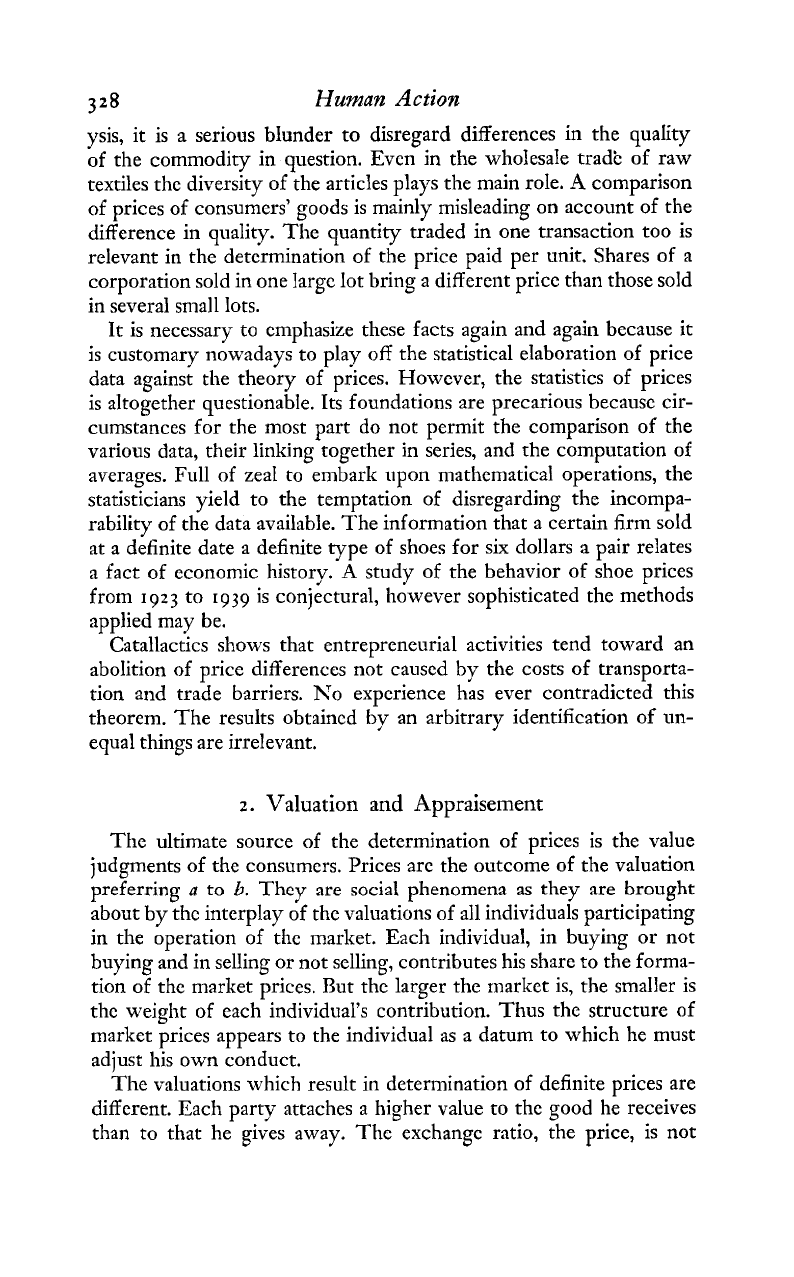
328
Hman
Action
ysis, it is a serious bIunder to disregard differences in the quality
of the commodity in question. Even in the wholesale tradi: of raw
textiles the diversity of the articles plays the main role.
A
comparison
of prices of consumers' goods is mainly misleading on account of the
difference in quality. The quantity traded in one transaction too is
relevant in the determination of the price paid per unit. Shares of a
corporation sold in one large lot bring a different price than those sold
in several small lots.
It is necessary to emphasize these facts again and again because
it
is customary nowadays to play
off
the statistical elaboration of price
data against the theory of prices. However, the statistics of prices
is altogether questionable. Its foundations are precarious because cir-
cumstances for the most part do not permit the comparison of the
various data, their linking together in series, and the computation of
averages. Full of zeaI to embark upon mathematical operations, the
statisticians yield to the temptation of disregarding the incompa-
rability of the data available. The information that a certain firm sold
at a definite date a definite type of shoes for six dollars a pair relates
a fact of economic history.
A
study of the behavior of shoe prices
from
1923
to
1939
is conjectural, however sophisticated the methods
applied may be.
Catallactics shows that entrepreneurial activities tend toward an
abolition of price differences not caused by the costs of transporta-
tion and trade barriers. No experience has ever contradicted this
theorem. The results obtained by an arbitrary identification of un-
equal things are irrelevant.
2.
Valuation
and
Appraisement
The ultimate source of the determination of prices is the value
judgments of the consumers. Prices are the outcome of the valuation
preferring
LI
to
6.
They are social phenomena as they are brought
about by thc interplay of the valuations of all individuals participating
in the operation of the market. Each individual, in buying or not
buying and in selling or not selling, contributes his share to the forma-
tion of the market prices. But the larger the market is, the smaller is
the weight of each individual's contribution. Thus the structure of
market prices appears to the individual as a datum to which he must
adjust his own conduct.
The valuations which result in determination of definite prices are
different. Each party attaches a higher value to the good he receives
than to that he gives away. The exchange ratio, the price, is not
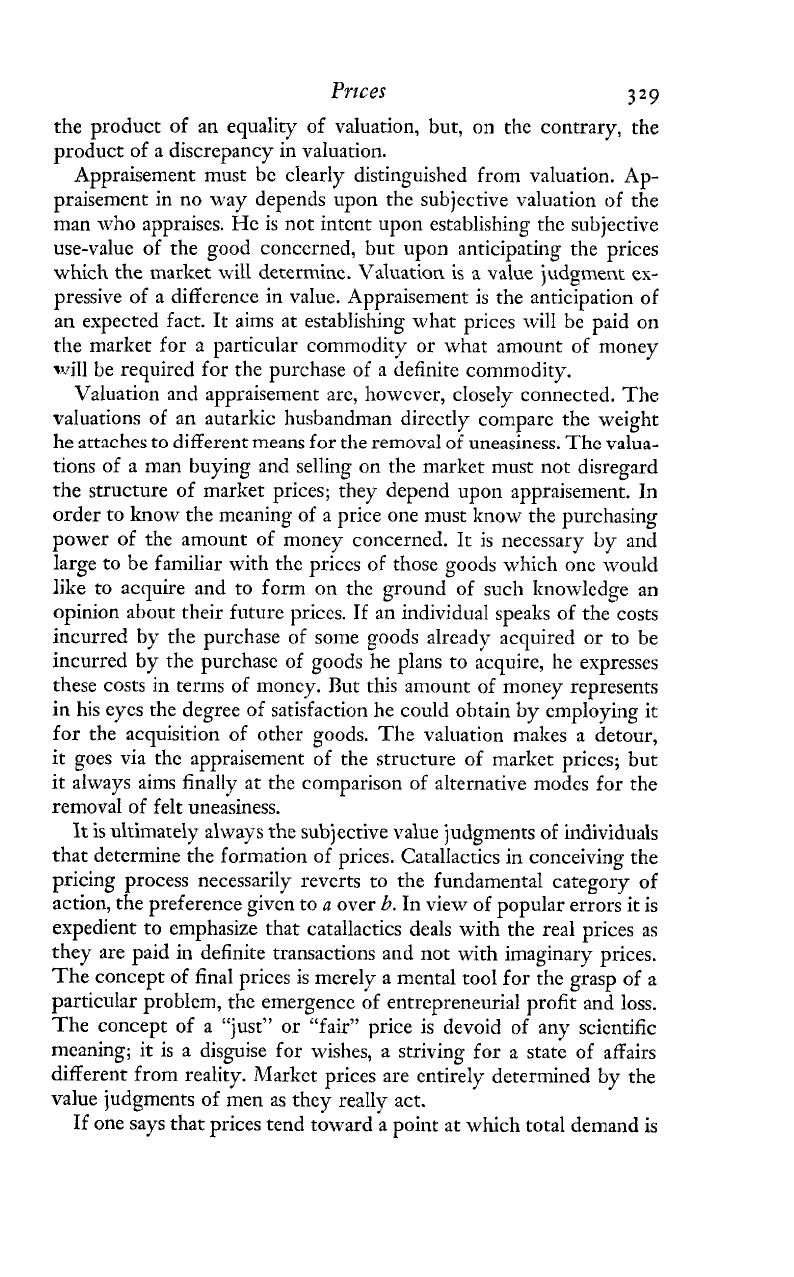
Przces
3
29
the product of an equality of valuation, but, on the contrary, the
product of a discrepancy in valuation.
Appraisement must be clearly distinguished from valuation. Ap-
praisement in no way depends upon the subjective valuation of the
man who appraises. He is not intent upon establishing the subjective
use-value of the good concerned, but upon anticipating the prices
which
the market
will
determine. Valuation
is
a value
judgment
ex-
pressive of a difference in value. Appraisement is the anticipation of
an expected fact. It aims at establishing what prices will be paid on
the market for a particular commodity or what amount of money
ill
be required for the purchase of a definite cormrnodity.
Valuation and appraisement arc, however, closely connected. The
valuations of an autarkic husbandman directly compare the weight
he attaches
to
different means for the removal of uneasiness. The valua-
tions of a man buying and selling on the market must not disregard
the structure of market prices; they depend upon appraisement.
In
order to know the meaning of a price one must know the purchasing
power of the amount of moncy concerned. It is necessary by and
large to be familiar with the prices of those goods which one would
like to acquire and to form on the ground of such Itnowledge an
opinion a1)ont their future prices. If an individual speaks of the costs
incurred by the purchase of some goods already acquired or to be
incurred by the purchase of goods he plans to acquire, he expresses
these costs in term of moncy. But this amount of money represents
in his eyes the degree of satisfaction he could obtain by employing it
for the acquisition of other goods. The valuation ~nakes a detour,
it goes via the appraisement of the structure of market prices; but
it always aims finally at the comparison of alternative modes for the
removal of felt uneasiness.
It
is
ultimately always the subjective value judgments of individuals
that determine the formation of prices. CatalIactics in conceiving the
pricing process necessarily reverts to the fundamental category of
action, the preference given to
a
over
b.
In view of popular errors it is
expedient to emphasize that catallactics deals with the real prices as
they are paid in definite transactions and not with imaginary prices.
The
concept of final prices is merely a mental tool for the grasp of a
particular problem, the emergence of entrepreneurial profit and loss.
The concept of a "just" or "fair" price is devoid of any scientific
meaning; it is a disguise for wishes, a striving for a state of affairs
different from reality. Market prices are entirely determined by the
value judgments of men as they really act.
If one says that prices tend toward a point at
which
total demand is
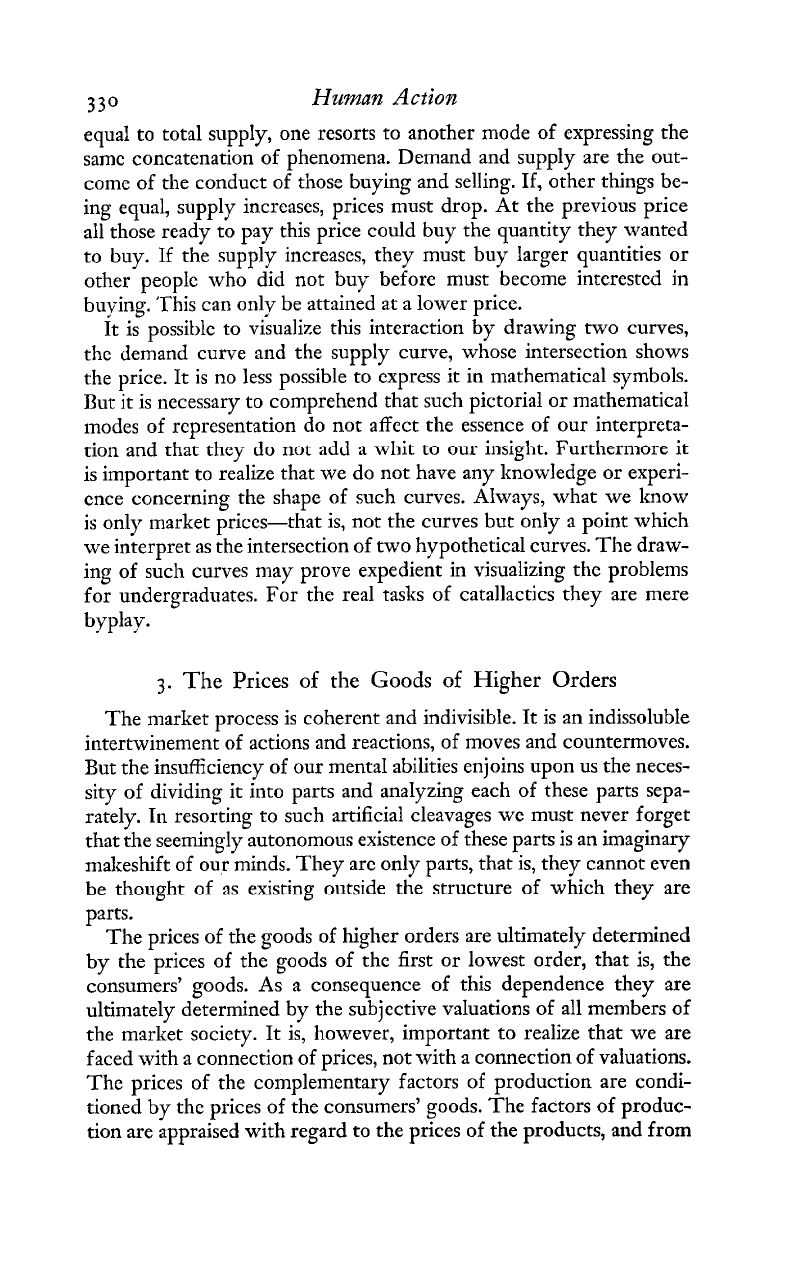
3
30
Human
Action
equal to total supply, one resorts to another mode of expressing the
same concatenation of phenomena. Demand and supply are the out-
come of the conduct of those buying and selling. If, other things be-
ing equal, supply increases, prices must drop. At the previous price
all those ready to pay this price could buy the quantity they wanted
to buy. If the supply increases, they must buy larger quantities or
other people who did not buy before must become interested in
buying. 'This can only be attained at a lower price.
It is possible to visualize this interaction by drawing two curves,
the demand curve and the supply curve, whose intersection shows
the price. It is no less possibIe to express it in mathematical symbols.
But it is necessary to comprehend that such pictorial or mathematical
modes of representation do not affect the essence of our interpreta-
tion and that they do not add a whit to our insight. Furthermore it
is important to realize that we do not have any knowledge or experi-
ence concerning the shape of such curves. Always, what we know
is only market prices-that is, not the curves but only a point which
we interpret as the intersection of two hypothetical curves. The draw-
ing of such curves may prove expedient in visualizing the problems
for undergraduates. For the real tasks of catallactics they are mere
byplay.
3.
The
Prices of the Goods of Higher Orders
The market process is coherent and indivisible. It is an indissoluble
intertwinement of actions and reactions, of moves and countermoves.
But the insufficiency of our mentaI abilities enjoins upon us the neces-
sity of dividing
it
into parts and analyzing each of these parts sepa-
rately. In resorting to such artificial cleavages
we
must never forget
that the seemingly autonomous existence of these parts is an imaginary
makeshift of our minds. They are only parts, that is, they cannot even
be
thought
of
as
existing
outside the structure of which they are
parts.
The prices of the goods of higher orders are ultimately determined
by the prices of the goods of the first or lowest order, that is, the
consumers' goods.
As
a consequence of this dependence they are
ultimately determined by the subjective vahations of all members of
the market society. It is, however, important to realize that we are
faced with a connection of prices, not with a connection of valuations.
The prices of the complementary factors of production are condi-
tioned by the prices of the consumers' goods. The factors of produc-
tion are appraised with regard to the prices of the products, and from
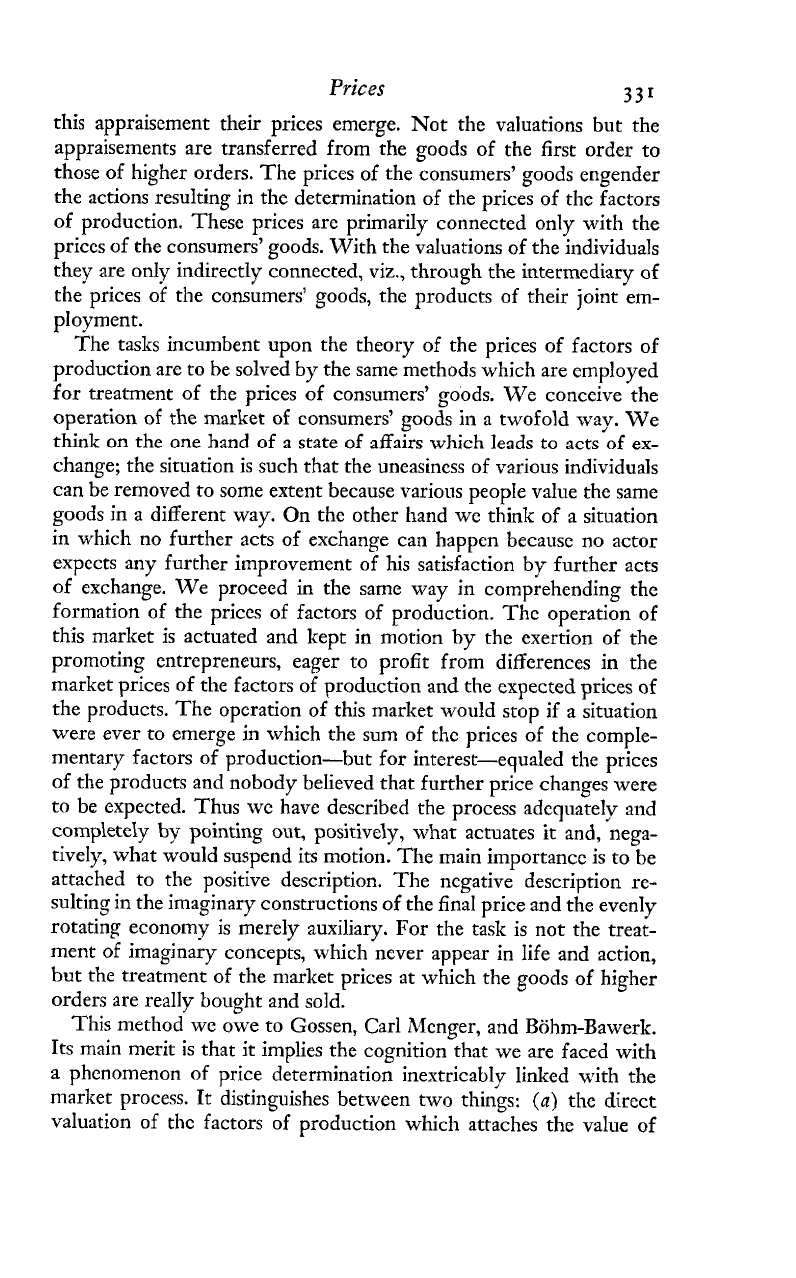
Prices
331
this appraisement their prices emerge. Not the valuations but the
appraisements are transferred from the goods of the first order to
those of higher orders. The prices of the consumers' goods engender
the actions resulting in the determination of the prices of the factors
of production. These prices are primarily connected only with the
prices of the consumers' goods. With the valuations of the individuals
they are only indirectly connected, viz., through the intermediary
of
thewprices
03
the consumers' goods, the products of their joint em-
ployment.
The tasks incumbent upon the theory of the prices of factors of
production are to be solved
by
the same methods which are employed
for treatment of the prices of consumers' goods. We conceive the
operation of the market of consumers' goods in a twofold way. We
think on the one hand of a state of affairs which leads to acts of ex-
change; the situation is such that the uneasiness of various individuals
can be removed to some extent because various peopIe value the same
goods in
a
different way.
On
the other hand we think of a situation
in which no further acts of exchange can happen because no actor
expects any further improvement of his satisfaction by further acts
of exchange. We proceed in the same way in comprehending the
formation of the prices of factors of production. The operation of
this market is actuated and kept in motion by the exertion of the
promoting entrepreneurs, eager to profit from differences in the
market prices of the factors of production and the expected prices
of
the products. The operation of this market would stop if a situation
were ever to emerge in which the sum of the prices of the comple-
mentary factors of production-but for interest-equaled the prices
of the products and nobody believed that further price changes were
to be expected. Thus
wc
have described the process adequately and
completely
by
pointing out, positively, what actuates
it
and, nega-
tively, what would suspend its motion. The main importance is to be
attached to the positive description. The negative description re-
sulting in the imaginary constructions of the final price and the evenly
rotating economy is merely auxiliary. For the task is not the treat-
ment of imaginaEy concepts, which never appear in Iife and action,
but the treatment of the market prices at which the goods of higher
orders are really bought and sold.
This method we owe to Gossen, Carl Mcnger, and Biihm-Bawerk.
Its main merit is that it implies the cognition that we are faced with
a phenomenon of price determination inextricably linked with the
market process. It distinguishes between two things:
(a)
the direct
valuation of the factors of production which attaches the value of
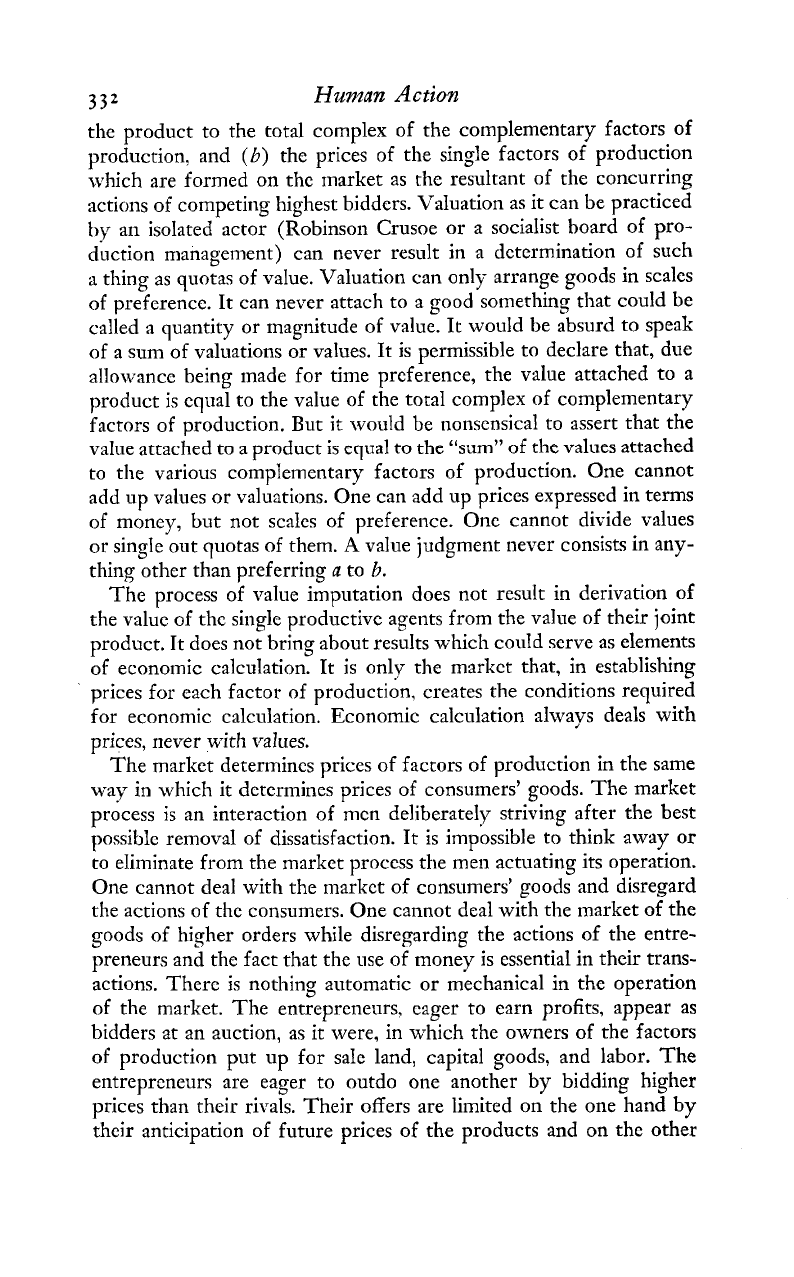
332
Human
Action
the product to the total complex of the cotnplementary factors of
production. and
(6)
the prices of the single factors of production
which are formed on the market as rhc resultant of the concurring
actions of competing highest bidders. Valuation as it can be practiced
by
an isolated actor (Robinson Crusoe or a socialist board of pro-
diction management) can never result in a
determination
of such
a
thing as quotas of value. Valuation can only arrange goods in scales
of prefcrence. It can never attach to a good something that could be
called a quantity or magnitude of value. It would be absurd to speak
of a sum of valuations or values. It is permissible to declare that, due
allowance being made for time preference, the value attached to a
product is equal to the value of the total complex of complementary
factors of production. But
it
would be nonsensical to assert that the
value attached to a product is equal to the "sum" of the values attached
to the various complementary factors of production. One cannot
add up values or valuations. One can add up prices expressed in terms
of money, but not scales of preference. One cannot divide values
or single out quotas of them.
A
value judgment never consists in any-
thing other than preferring
a
to
h.
The process of value imputation does not result in derivation of
the value of the singlc productive agents from the value of their joint
product. It does not bring about results which could serve as elements
of economic calculation. It is onlv the markct that, in establishing
prices for each factor of productidn, creates the conditions required
for economic calculation. Economic calculation always deals with
prices, never with values.
The market determines prices of factors of production in the same
way
in
which it determines prices of consumers' goods. The market
process is an interaction of mcn deliberately striving after the best
possible ren~oval of dissatisfaction. It is impbssible to think away or
to eliminate from the market proccss the men actuating its operation.
One cannot deal with the rnarkct of consumers' goods and disregard
the actions of the consumers. One cannot deal with the market of the
goods of higher orders while disregarding the actions of the entre-
preneurs and the fact that the use of money is essential in their trans-
actions. There is nothing automatic or mechanical in the operation
of the market. The entrepreneurs, eager to earn profits, appear as
bidders at an auction, as it were, in which the owners of the factors
of production put up for sale land, capital goods, and labor. The
entrepreneurs are eager to outdo one another by bidding higher
prices than thcir rivals. Their offers are limited on the one hand by
their anticipation of future prices of the products and on the other
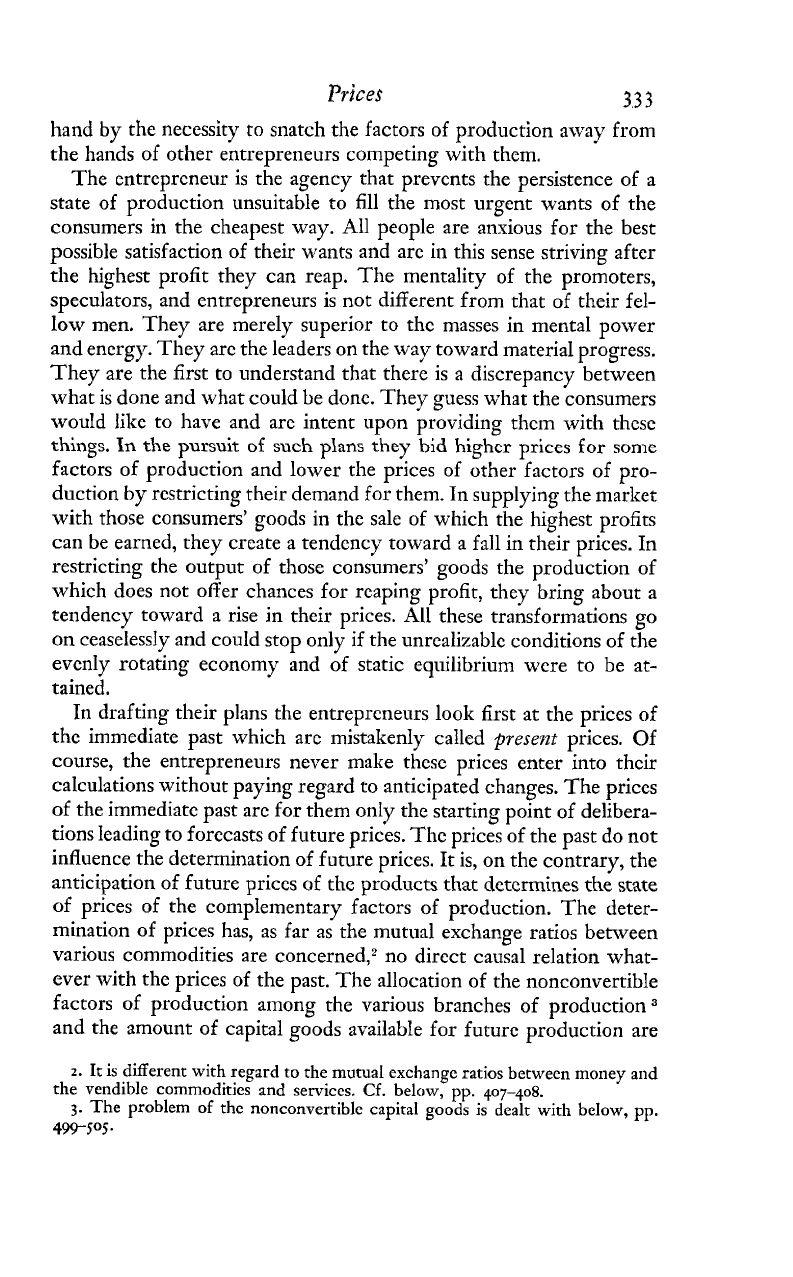
Prices
hand by the necessity to snatch the factors of production away from
the hands of other entrepreneurs competing with thcm.
The
entrepreneur
is the agency that prevcnts the persistence of a
state of production unsuitable to fill the most urgent wants of the
consumers in the cheapest way. All people are anxious for the best
possible satisfaction of their wants and arc in this sense striving after
the highest profit they can reap. The mentality of the promoters,
speculators, and entrepreneurs is not different from that of their fel-
low men. They are merely superior to thc masses in mental power
and energy. They are the leaders on the way toward material progress.
They are the first to understand that there is a discrepancy between
what is done and what could be done. They guess what the consumers
would like to have and arc intent upon providing them with these
things.
In
the pursuit
of
such
plans
they
bid
higher prices for some
factors of production and lower the prices of other factors of pro-
duction by restricting their demand for them. In supplying the market
with those consumers' goods in the sale of which the highest profits
can be earned, they create a tendcncy toward a fall in their prices. In
restricting the output of those consumers' goods the production of
which does not offer chances for reaping profit, they bring about a
tendency toward a rise in their prices. All these transformations go
on ceaselessly and could stop only if the unrealizable conditions of the
evenly rotating economy and of static equilibrium were to be at-
tained.
In drafting their plans the entrepreneurs look first at the prices of
the immediate past which are mistakenly called
presefzt
prices. Of
course, the entrepreneurs never make these prices enter into their
calculations without paying regard to anticipated changes. The prices
of the immediate past are for them only the starting point of delibera-
tions Ieading to forecasts of future prices. The prices of the past do not
influence the determination of future prices. It is, on the contrary, the
anticipation of future prices of the products that determines
the
state
of prices of the complementary factors of production. The deter-
mination of prices has, as far as the mutual exchange ratios between
various commodities are concerned,"~ direct causal relation what-
ever with the prices of the past. The allocation of the nonconvertible
factors of production among the various branches of production
and the amount of capital goods availabIe for future production are
2.
It
is different with regard to the mutual exchange ratios between money and
the vendible commodities and services.
Cf.
below,
pp.
407-408.
3.
The problem
of
the nonconvertible capital goods is dealt with below,
pp.
499-505.
